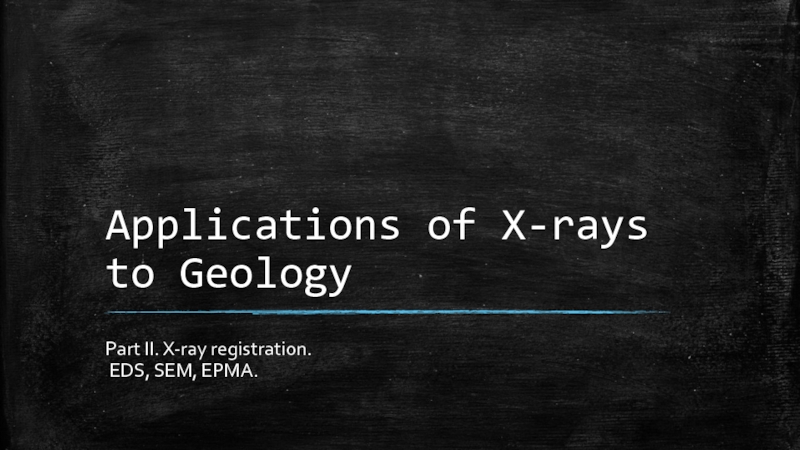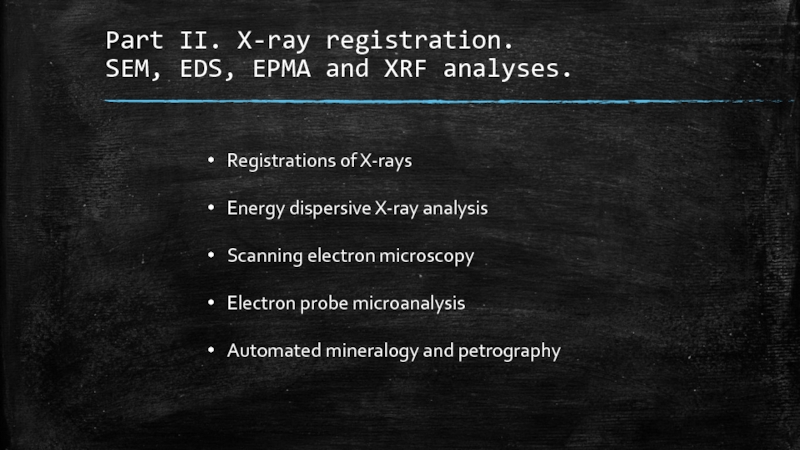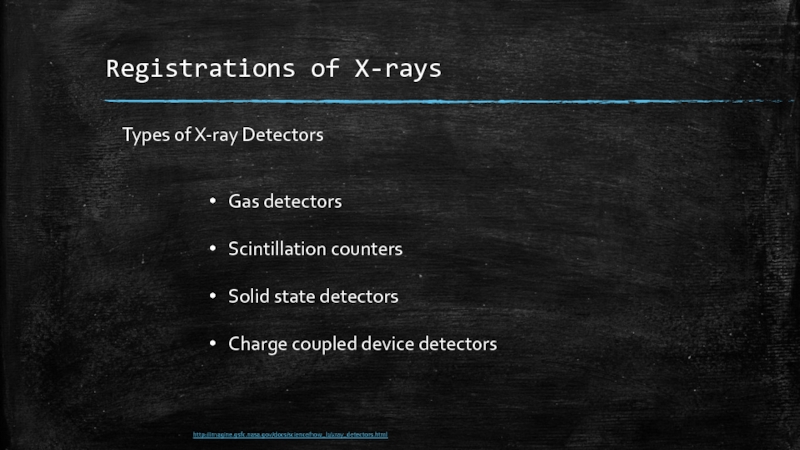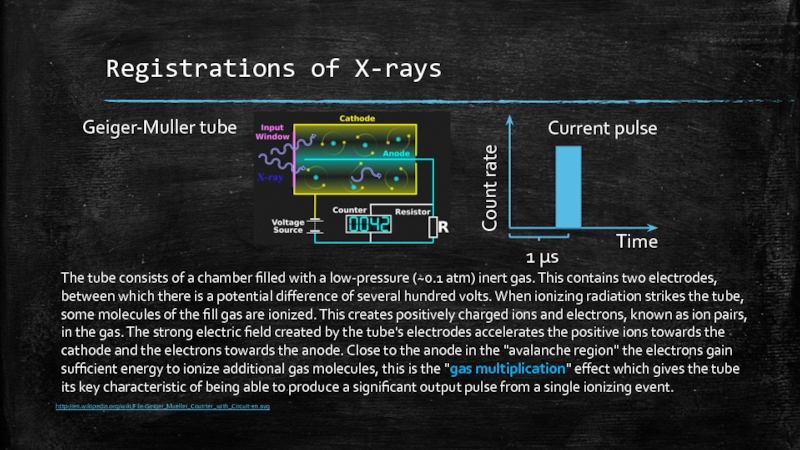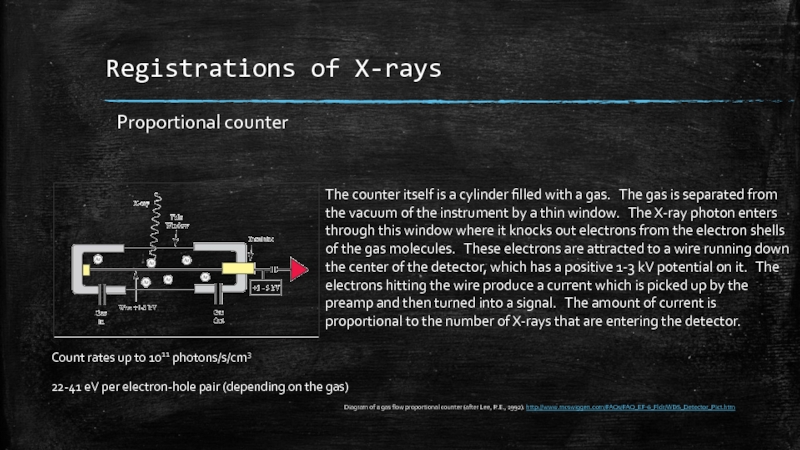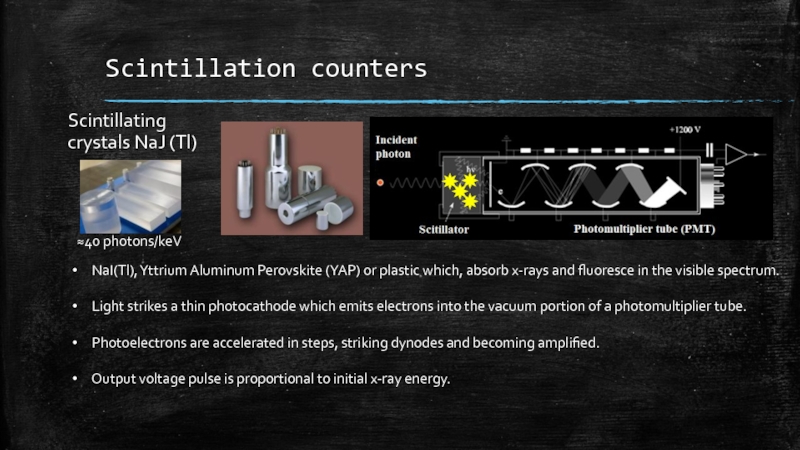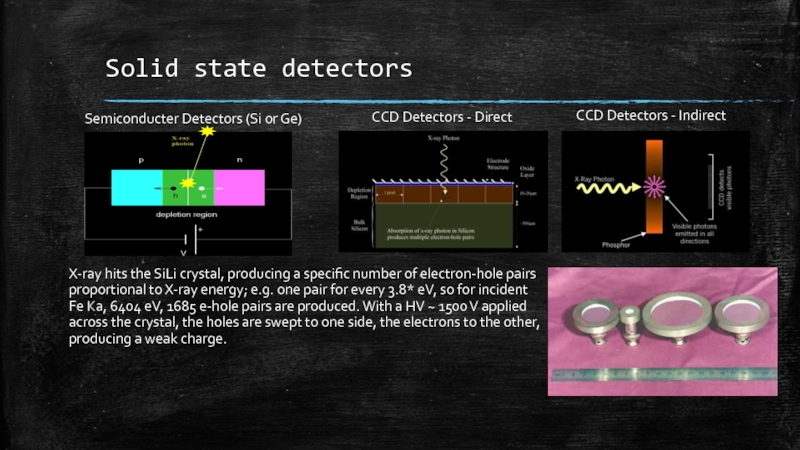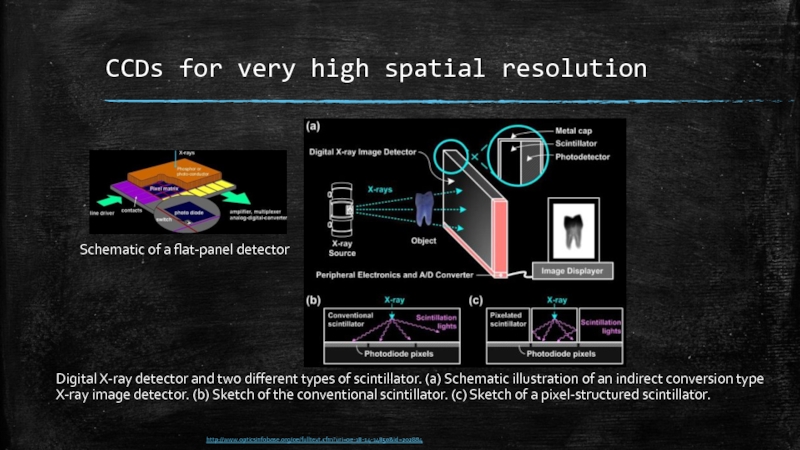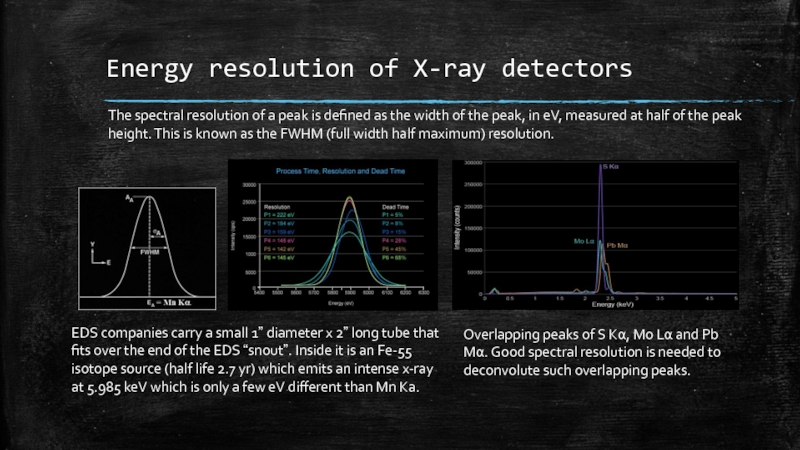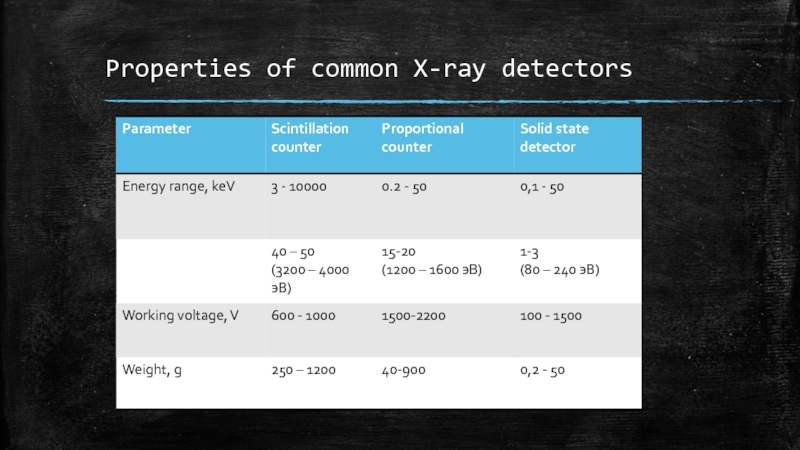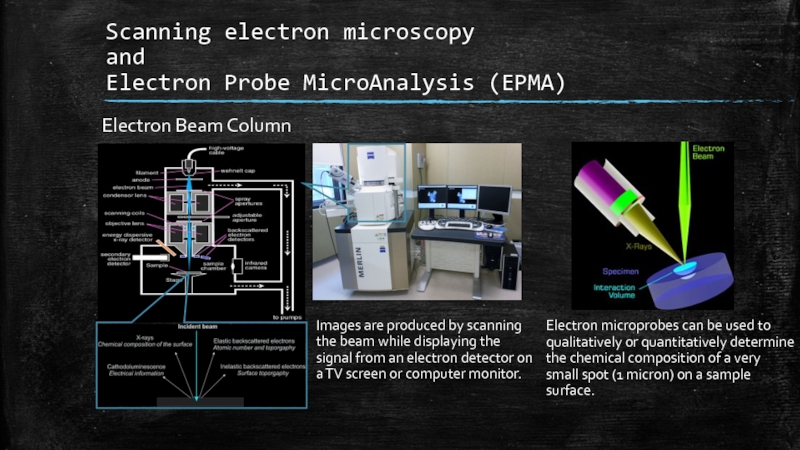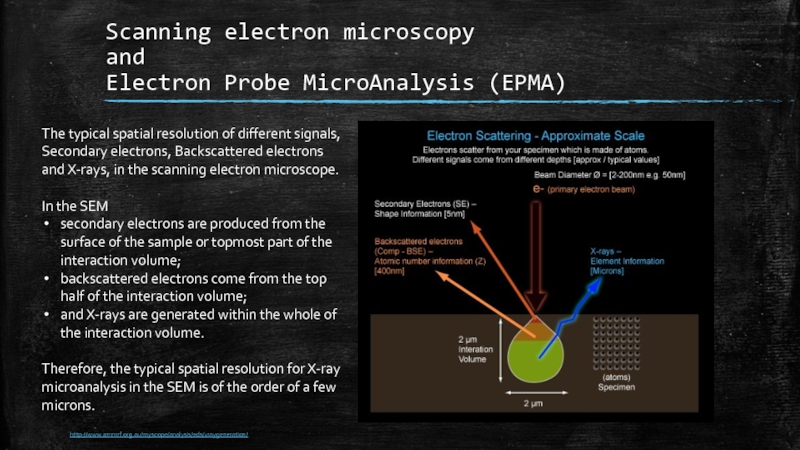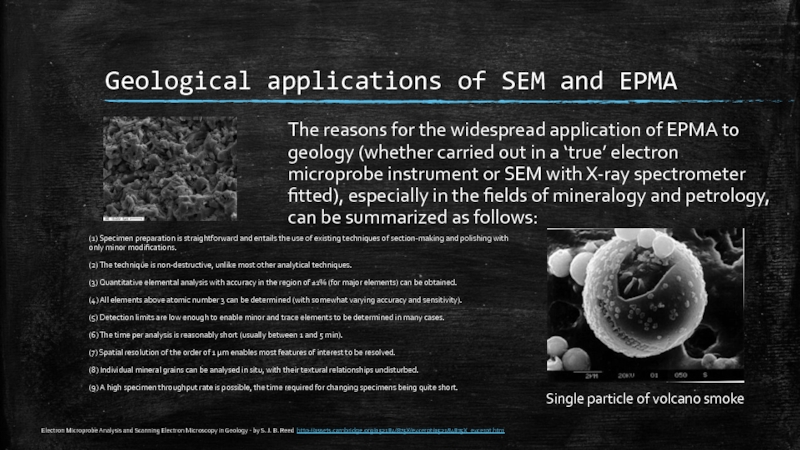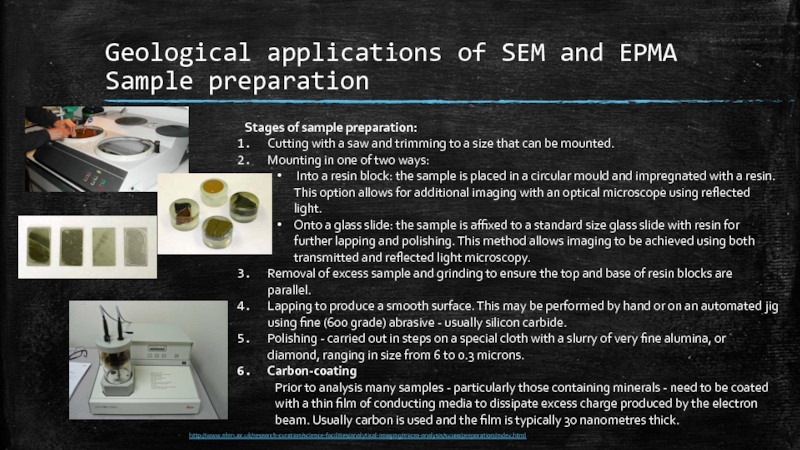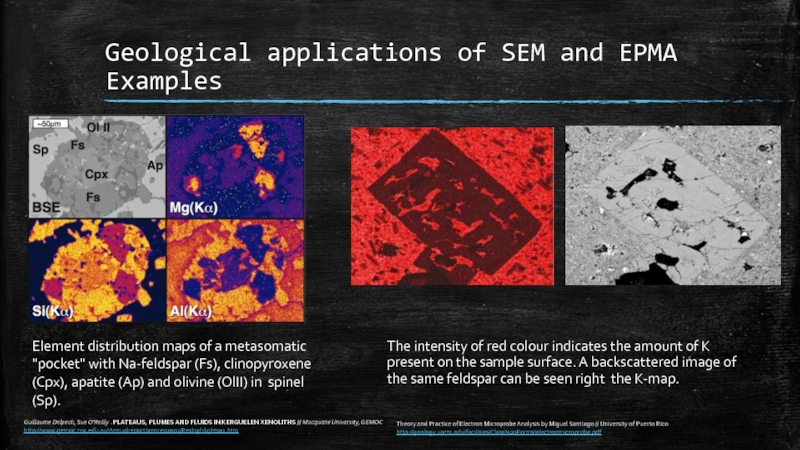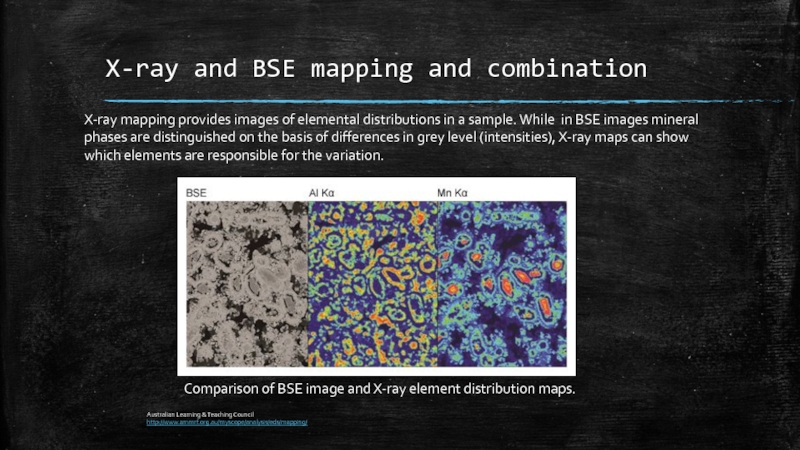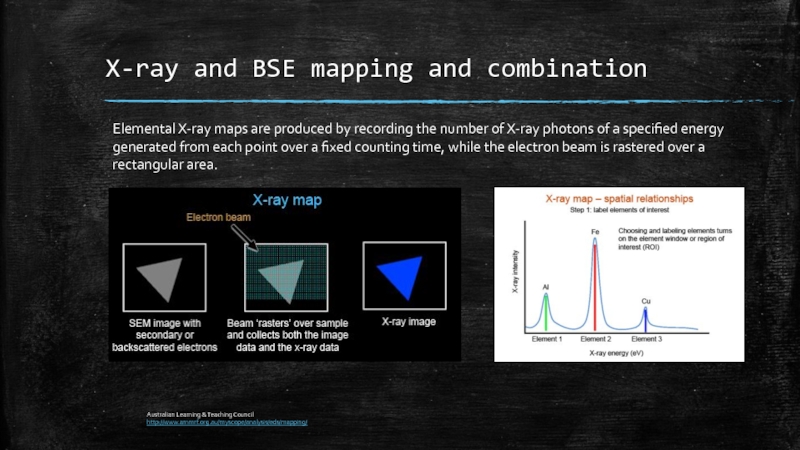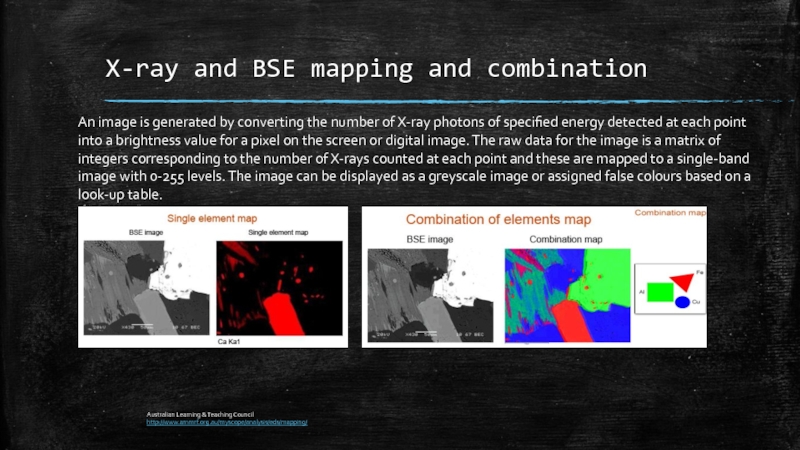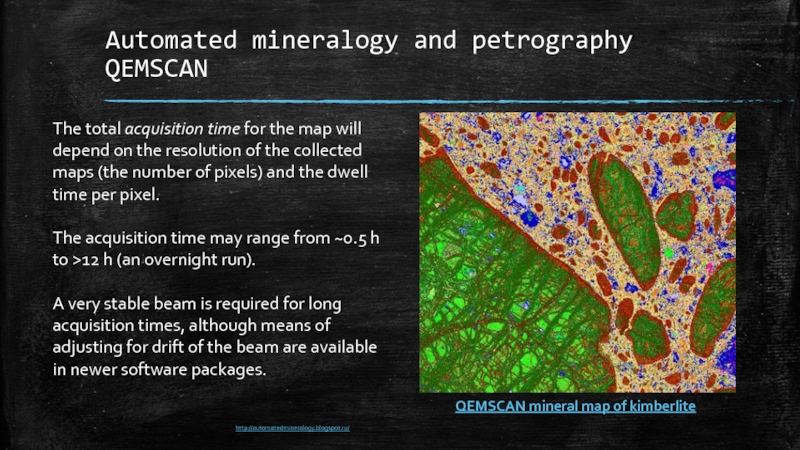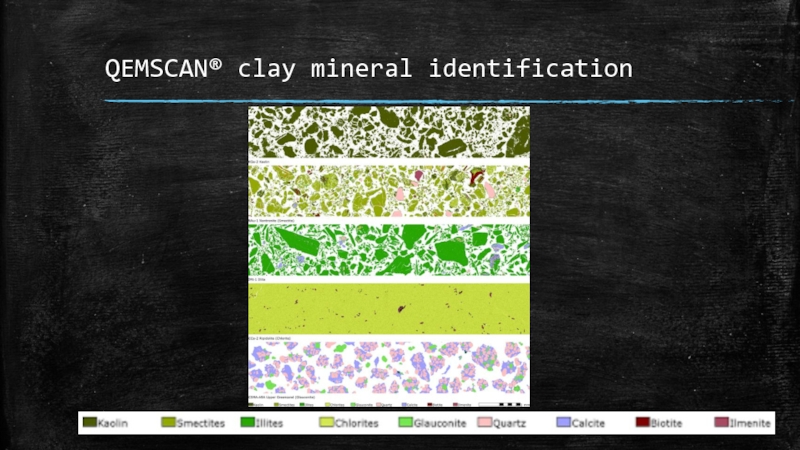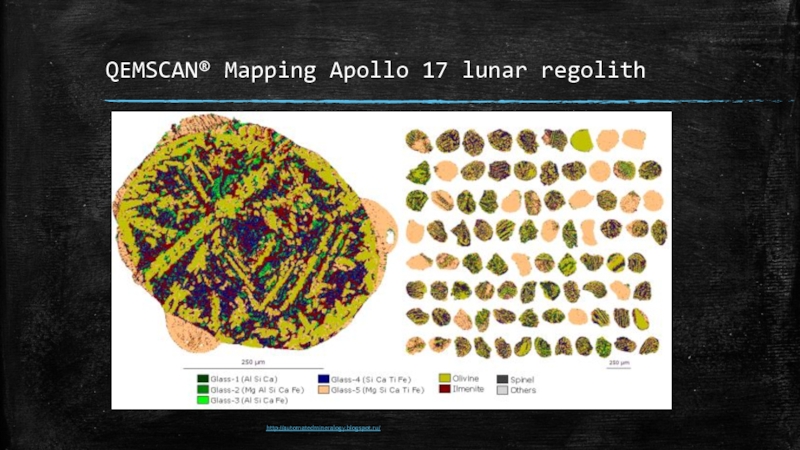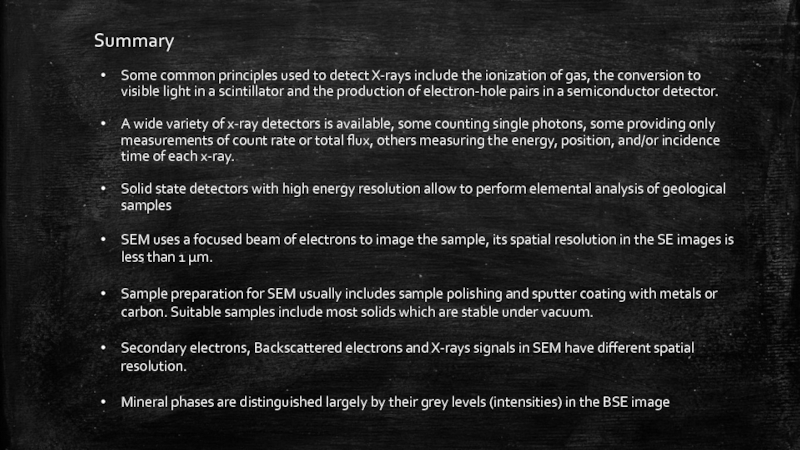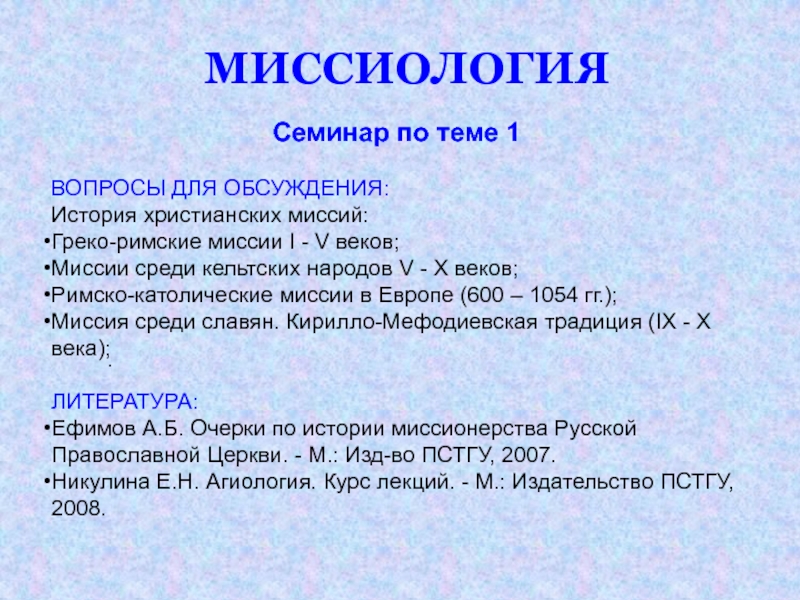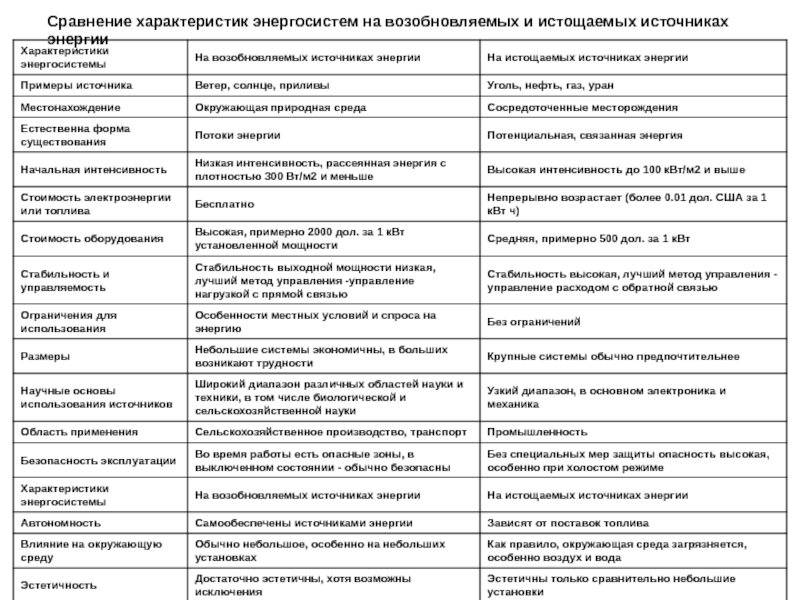Разделы презентаций
- Разное
- Английский язык
- Астрономия
- Алгебра
- Биология
- География
- Геометрия
- Детские презентации
- Информатика
- История
- Литература
- Математика
- Медицина
- Менеджмент
- Музыка
- МХК
- Немецкий язык
- ОБЖ
- Обществознание
- Окружающий мир
- Педагогика
- Русский язык
- Технология
- Физика
- Философия
- Химия
- Шаблоны, картинки для презентаций
- Экология
- Экономика
- Юриспруденция
Applications of X-rays to Geology
Содержание
- 1. Applications of X-rays to Geology
- 2. Part II. X-ray registration. SEM, EDS,
- 3. Registrations of X-rays http://imagine.gsfc.nasa.gov/docs/science/how_l1/xray_detectors.htmlGas detectorsScintillation countersSolid state detectorsCharge coupled device detectorsTypes of X-ray Detectors
- 4. Registrations of X-rays Geiger-Muller tubehttp://en.wikipedia.org/wiki/File:Geiger_Mueller_Counter_with_Circuit-en.svgThe tube consists
- 5. Registrations of X-rays Proportional counterDiagram of a
- 6. Scintillation countersScintillating crystals NaJ (Tl) NaI(Tl), Yttrium
- 7. Solid state detectorsX-ray hits the SiLi crystal,
- 8. CCDs for very high spatial resolutionSchematic of
- 9. Energy resolution of X-ray detectorsThe spectral resolution
- 10. Properties of common X-ray detectors
- 11. Scanning electron microscopy and Electron Probe
- 12. Scanning electron microscopy and Electron Probe
- 13. Geological applications of SEM and EPMASingle
- 14. Geological applications of SEM and EPMA Sample
- 15. Geological applications of SEM and EPMA ExamplesGuillaume
- 16. X-ray and BSE mapping and combinationAustralian Learning
- 17. X-ray and BSE mapping and combinationAustralian Learning
- 18. X-ray and BSE mapping and combinationAustralian Learning
- 19. Automated mineralogy and petrography QEMSCAN http://automatedmineralogy.blogspot.ru/The total
- 20. QEMSCAN® clay mineral identification http://automatedmineralogy.blogspot.ru/
- 21. QEMSCAN® Mapping Apollo 17 lunar regolith http://automatedmineralogy.blogspot.ru/
- 22. Reference Books
- 23. SummarySome common principles used to detect X-rays
- 24. Скачать презентанцию
Слайды и текст этой презентации
Слайд 2Part II. X-ray registration.
SEM, EDS, EPMA and XRF analyses.
Registrations
of X-rays
Energy dispersive X-ray analysis
Scanning electron microscopy
Electron probe microanalysis
Automated
mineralogy and petrographyСлайд 3Registrations of X-rays
http://imagine.gsfc.nasa.gov/docs/science/how_l1/xray_detectors.html
Gas detectors
Scintillation counters
Solid state detectors
Charge coupled device
detectors
Types of X-ray Detectors
Слайд 4Registrations of X-rays
Geiger-Muller tube
http://en.wikipedia.org/wiki/File:Geiger_Mueller_Counter_with_Circuit-en.svg
The tube consists of a
chamber filled with a low-pressure (~0.1 atm) inert gas. This
contains two electrodes, between which there is a potential difference of several hundred volts. When ionizing radiation strikes the tube, some molecules of the fill gas are ionized. This creates positively charged ions and electrons, known as ion pairs, in the gas. The strong electric field created by the tube's electrodes accelerates the positive ions towards the cathode and the electrons towards the anode. Close to the anode in the "avalanche region" the electrons gain sufficient energy to ionize additional gas molecules, this is the "gas multiplication" effect which gives the tube its key characteristic of being able to produce a significant output pulse from a single ionizing event.1 µs
Count rate
Current pulse
Слайд 5Registrations of X-rays
Proportional counter
Diagram of a gas flow
proportional counter (after Lee, R.E., 1992). http://www.mcswiggen.com/FAQs/FAQ_EF-6_Fldr/WDS_Detector_Pict.htm
The counter itself is
a cylinder filled with a gas. The gas is separated from the vacuum of the instrument by a thin window. The X-ray photon enters through this window where it knocks out electrons from the electron shells of the gas molecules. These electrons are attracted to a wire running down the center of the detector, which has a positive 1-3 kV potential on it. The electrons hitting the wire produce a current which is picked up by the preamp and then turned into a signal. The amount of current is proportional to the number of X-rays that are entering the detector. Count rates up to 1011 photons/s/cm3
22-41 eV per electron-hole pair (depending on the gas)
Слайд 6Scintillation counters
Scintillating
crystals NaJ (Tl)
NaI(Tl), Yttrium Aluminum Perovskite (YAP)
or plastic which, absorb x-rays and fluoresce in the visible
spectrum.Light strikes a thin photocathode which emits electrons into the vacuum portion of a photomultiplier tube.
Photoelectrons are accelerated in steps, striking dynodes and becoming amplified.
Output voltage pulse is proportional to initial x-ray energy.
≈40 photons/keV
Слайд 7Solid state detectors
X-ray hits the SiLi crystal, producing a specific
number of electron-hole pairs proportional to X-ray energy; e.g. one
pair for every 3.8* eV, so for incident Fe Ka, 6404 eV, 1685 e-hole pairs are produced. With a HV ~ 1500 V applied across the crystal, the holes are swept to one side, the electrons to the other, producing a weak charge.CCD Detectors - Direct
CCD Detectors - Indirect
Semiconducter Detectors (Si or Ge)
Слайд 8CCDs for very high spatial resolution
Schematic of a flat-panel detector
Digital
X-ray detector and two different types of scintillator. (a) Schematic
illustration of an indirect conversion type X-ray image detector. (b) Sketch of the conventional scintillator. (c) Sketch of a pixel-structured scintillator.http://www.opticsinfobase.org/oe/fulltext.cfm?uri=oe-18-14-14850&id=202884
Слайд 9Energy resolution of X-ray detectors
The spectral resolution of a peak
is defined as the width of the peak, in eV,
measured at half of the peak height. This is known as the FWHM (full width half maximum) resolution.EDS companies carry a small 1” diameter x 2” long tube that fits over the end of the EDS “snout”. Inside it is an Fe-55 isotope source (half life 2.7 yr) which emits an intense x-ray at 5.985 keV which is only a few eV different than Mn Ka.
Overlapping peaks of S Kα, Mo Lα and Pb Mα. Good spectral resolution is needed to deconvolute such overlapping peaks.
Слайд 11
Scanning electron microscopy
and
Electron Probe MicroAnalysis (EPMA)
Electron microprobes can be used
to qualitatively or quantitatively determine the chemical composition of a
very small spot (1 micron) on a sample surface.Images are produced by scanning the beam while displaying the signal from an electron detector on a TV screen or computer monitor.
Electron Beam Column
Слайд 12
Scanning electron microscopy
and
Electron Probe MicroAnalysis (EPMA)
The typical spatial resolution of
different signals, Secondary electrons, Backscattered electrons and X-rays, in the
scanning electron microscope.In the SEM
secondary electrons are produced from the surface of the sample or topmost part of the interaction volume;
backscattered electrons come from the top half of the interaction volume;
and X-rays are generated within the whole of the interaction volume.
Therefore, the typical spatial resolution for X-ray microanalysis in the SEM is of the order of a few microns.
http://www.ammrf.org.au/myscope/analysis/eds/xraygeneration/
Слайд 13
Geological applications of SEM and EPMA
Single particle of volcano smoke
The
reasons for the widespread application of EPMA to geology (whether
carried out in a ‘true’ electron microprobe instrument or SEM with X-ray spectrometer fitted), especially in the fields of mineralogy and petrology, can be summarized as follows:(1) Specimen preparation is straightforward and entails the use of existing techniques of section-making and polishing with only minor modifications.
(2) The technique is non-destructive, unlike most other analytical techniques.
(3) Quantitative elemental analysis with accuracy in the region of ±1% (for major elements) can be obtained.
(4) All elements above atomic number 3 can be determined (with somewhat varying accuracy and sensitivity).
(5) Detection limits are low enough to enable minor and trace elements to be determined in many cases.
(6) The time per analysis is reasonably short (usually between 1 and 5 min).
(7) Spatial resolution of the order of 1 μm enables most features of interest to be resolved.
(8) Individual mineral grains can be analysed in situ, with their textural relationships undisturbed.
(9) A high specimen throughput rate is possible, the time required for changing specimens being quite short.
Electron Microprobe Analysis and Scanning Electron Microscopy in Geology - by S. J. B. Reed http://assets.cambridge.org/052184/875X/excerpt/052184875X_excerpt.htm
Слайд 14Geological applications of SEM and EPMA
Sample preparation
Stages of sample preparation:
Cutting
with a saw and trimming to a size that can
be mounted.Mounting in one of two ways:
Into a resin block: the sample is placed in a circular mould and impregnated with a resin. This option allows for additional imaging with an optical microscope using reflected light.
Onto a glass slide: the sample is affixed to a standard size glass slide with resin for further lapping and polishing. This method allows imaging to be achieved using both transmitted and reflected light microscopy.
Removal of excess sample and grinding to ensure the top and base of resin blocks are parallel.
Lapping to produce a smooth surface. This may be performed by hand or on an automated jig using fine (600 grade) abrasive - usually silicon carbide.
Polishing - carried out in steps on a special cloth with a slurry of very fine alumina, or diamond, ranging in size from 6 to 0.3 microns.
Carbon-coating
Prior to analysis many samples - particularly those containing minerals - need to be coated with a thin film of conducting media to dissipate excess charge produced by the electron beam. Usually carbon is used and the film is typically 30 nanometres thick.
http://www.nhm.ac.uk/research-curation/science-facilities/analytical-imaging/micro-analysis/sx100/preparation/index.html
Слайд 15Geological applications of SEM and EPMA
Examples
Guillaume Delpech, Sue O'Reilly .
PLATEAUS, PLUMES AND FLUIDS IN KERGUELEN XENOLITHS // Macquarie University,
GEMOChttp://www.gemoc.mq.edu.au/Annualreport/annrep2001/Reshighlights01.htm
Element distribution maps of a metasomatic "pocket" with Na-feldspar (Fs), clinopyroxene (Cpx), apatite (Ap) and olivine (OlII) in spinel (Sp).
The intensity of red colour indicates the amount of K present on the sample surface. A backscattered image of the same feldspar can be seen right the K-map.
Theory and Practice of Electron Microprobe Analysis by Miguel Santiago // University of Puerto Rico
http://geology.uprm.edu/facilities/Class%20Forms/electronmicroprobe.pdf
Слайд 16X-ray and BSE mapping and combination
Australian Learning & Teaching Council
http://www.ammrf.org.au/myscope/analysis/eds/mapping/
X-ray
mapping provides images of elemental distributions in a sample. While
in BSE images mineral phases are distinguished on the basis of differences in grey level (intensities), X-ray maps can show which elements are responsible for the variation.Comparison of BSE image and X-ray element distribution maps.
Слайд 17X-ray and BSE mapping and combination
Australian Learning & Teaching Council
http://www.ammrf.org.au/myscope/analysis/eds/mapping/
Elemental
X-ray maps are produced by recording the number of X-ray
photons of a specified energy generated from each point over a fixed counting time, while the electron beam is rastered over a rectangular area.Слайд 18X-ray and BSE mapping and combination
Australian Learning & Teaching Council
http://www.ammrf.org.au/myscope/analysis/eds/mapping/
An
image is generated by converting the number of X-ray photons
of specified energy detected at each point into a brightness value for a pixel on the screen or digital image. The raw data for the image is a matrix of integers corresponding to the number of X-rays counted at each point and these are mapped to a single-band image with 0-255 levels. The image can be displayed as a greyscale image or assigned false colours based on a look-up table.Слайд 19Automated mineralogy and petrography
QEMSCAN
http://automatedmineralogy.blogspot.ru/
The total acquisition time for the
map will depend on the resolution of the collected maps
(the number of pixels) and the dwell time per pixel.The acquisition time may range from ~0.5 h to >12 h (an overnight run).
A very stable beam is required for long acquisition times, although means of adjusting for drift of the beam are available in newer software packages.
QEMSCAN mineral map of kimberlite
Слайд 23Summary
Some common principles used to detect X-rays include the ionization
of gas, the conversion to visible light in a scintillator
and the production of electron-hole pairs in a semiconductor detector.A wide variety of x-ray detectors is available, some counting single photons, some providing only measurements of count rate or total flux, others measuring the energy, position, and/or incidence time of each x-ray.
Solid state detectors with high energy resolution allow to perform elemental analysis of geological samples
SEM uses a focused beam of electrons to image the sample, its spatial resolution in the SE images is less than 1 µm.
Sample preparation for SEM usually includes sample polishing and sputter coating with metals or carbon. Suitable samples include most solids which are stable under vacuum.
Secondary electrons, Backscattered electrons and X-rays signals in SEM have different spatial resolution.
Mineral phases are distinguished largely by their grey levels (intensities) in the BSE image
